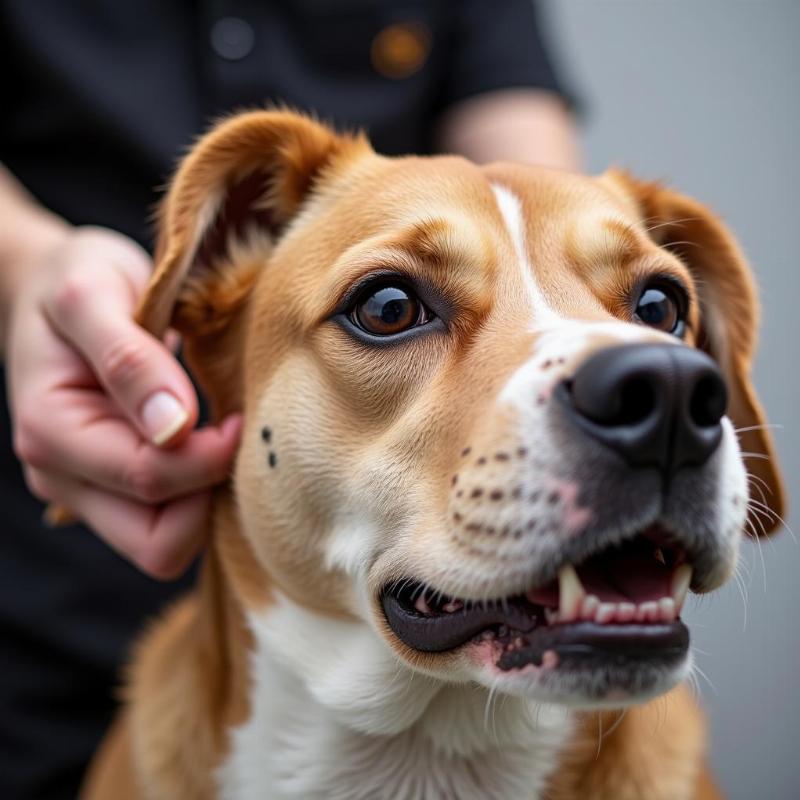Pet grooming is essential for a dog’s health and well-being, but it can be a daunting task for owners of aggressive dogs. Understanding the root of your dog’s aggression, employing proper handling techniques, and choosing the right grooming approach can make the experience safer and less stressful for both you and your furry friend. This article provides practical tips and strategies for pet grooming for aggressive dogs, ensuring a positive experience while maintaining their comfort and safety.
Understanding Your Dog’s Aggression
Before attempting to groom an aggressive dog, it’s crucial to identify the triggers for their behavior. Are they fearful, territorial, possessive, or in pain? Fear is often a primary cause, stemming from past negative experiences or a lack of socialization. Pinpointing the source of aggression helps tailor a grooming strategy that addresses their specific needs. For instance, a dog fearful of loud noises might benefit from a quieter grooming environment, while a dog possessive of its toys might require desensitization training before being handled. Recognizing these nuances is the first step towards successful grooming.
 Understanding Dog Aggression During Grooming
Understanding Dog Aggression During Grooming
Preparing for the Grooming Session
Creating a calm and predictable environment is essential. Choose a quiet, familiar location free from distractions. Using familiar scents like the dog’s blanket or toys can offer comfort. Having essential tools like muzzles, grooming loops, and calming aids readily available can ensure a smooth process. Introducing these tools gradually and positively can help desensitize the dog and prevent further anxiety during the actual grooming.
Safe Handling Techniques
Safety is paramount when grooming an aggressive dog. Muzzles, when used correctly, can prevent bites and allow for safe handling. Grooming loops provide gentle restraint, reducing the risk of injury. Approaching the dog slowly and calmly, speaking in soothing tones, and avoiding sudden movements are vital for building trust and minimizing stress. Rewarding calm behavior with treats and praise throughout the process reinforces positive associations with grooming.
Gradual Desensitization and Counter-Conditioning
For dogs with severe aggression, gradual desensitization and counter-conditioning are highly effective. This involves slowly introducing the dog to the sights, sounds, and sensations of grooming while pairing them with positive experiences like treats and praise. Start with short, manageable sessions and gradually increase the duration as the dog becomes more comfortable. This process requires patience and consistency but can significantly reduce aggression over time.
Professional Help
Sometimes, professional help is the best option. Certified professional groomers specializing in handling aggressive dogs have the experience and expertise to manage challenging behaviors safely and effectively. Veterinary behaviorists can address underlying anxiety or aggression issues, providing tailored behavior modification plans. Seeking professional assistance ensures the safety and well-being of both the dog and the owner.
Conclusion
Pet grooming for aggressive dogs requires patience, understanding, and a tailored approach. By identifying triggers, employing safe handling techniques, and considering professional help when necessary, owners can ensure a positive grooming experience for both themselves and their furry companions. Remember, prioritizing safety and building trust are key to making grooming a less stressful and more enjoyable experience.
FAQ
- Can I groom my aggressive dog myself? It depends on the severity of the aggression. Mild cases might be manageable with proper techniques, but professional help is recommended for severe aggression.
- What type of muzzle is best for grooming an aggressive dog? Basket muzzles allow for panting and drinking while preventing biting.
- How can I find a groomer experienced with aggressive dogs? Ask your veterinarian for recommendations or search online for groomers specializing in challenging behaviors.
- What are signs of stress in a dog during grooming? Panting, yawning, lip licking, whale eye, tucked tail, and attempts to escape are common signs of stress.
- How long does desensitization and counter-conditioning take? It varies depending on the dog and the severity of the aggression, but it can take weeks or even months.
- What if my dog bites during grooming? Stop the session immediately and consult a veterinarian or veterinary behaviorist.
- Are there any calming aids that can help with grooming? Consult your veterinarian about calming supplements or pheromone diffusers that might help reduce anxiety.
Connecting You With More Beautdogs.us Resources
To delve deeper into dog care, explore these related articles: why does my senior dog pant so much, old dog pants at night, excessive panting at night in dogs. For a broader understanding of senior dog care and potential respiratory concerns, check out old dog coughing and wheezing. And for a lighter touch on dog accessories and lifestyle, don’t miss stuffed animal dog on leash.
Beautdogs.us is your trusted source for comprehensive dog care information, breed insights, and product recommendations. We cater to both seasoned dog owners and those new to the joys of canine companionship. We provide expert guidance on grooming, training, nutrition, and overall wellness. Discover valuable resources and connect with a community of dog lovers. Contact us for personalized support via email at [email protected] or by phone at +1 501-555-7529. Beautdogs.us is here to help you navigate the wonderful world of dog ownership!